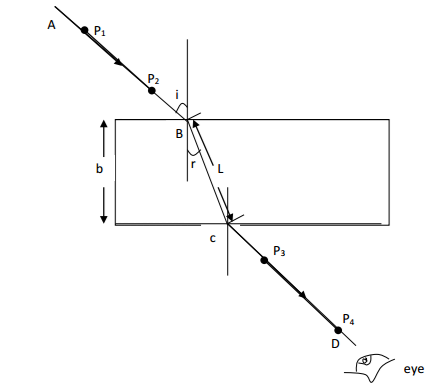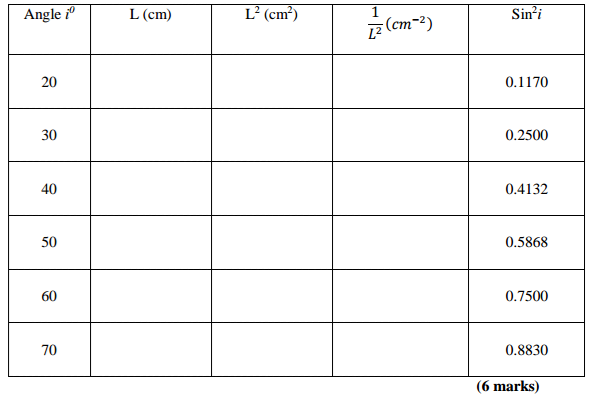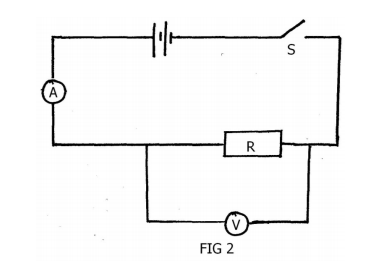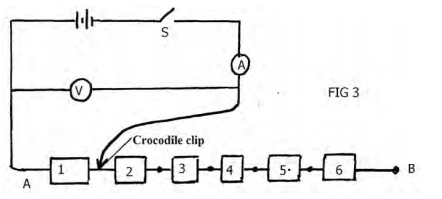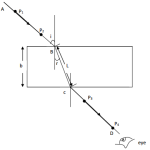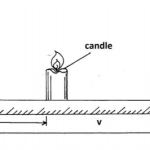KNEC KCSE Physics Paper 3 Question Paper / 2016 KCSE KAMDARA JET Examination
2016 KCSE KAMDARA JET Examination
Physics Paper 3
• a rectangular glass block
• 4 optical pins
• a soft board
• a plain paper
Proceed as follows:
(a) Place the glass block on the plain paper with one of the largest face upper most. Trace
round the glass block using a pencil as shown below.
(b) Remove the glass block and construct a normal at B. Construct an incident ray AB of
angle of incidence, i = 20o
(c) Replace the glass block and trace the ray ABCD using the optical pins.
(d) Remove the glass block and draw the path of the ray ABCD using a pencil. Measure
length L and record it in the table below.
(e) Repeat the procedure above for the angles of incidence given.
(f) Calculate the value of L2 and 1/L2 ; Record in the table.
(g) Plot a graph of 1/L2 (y-axis) against Sin2i.(5 marks)
(h) Calculate the gradient, S. (3 marks)
………………………………………………………………………………………………………
………………………………………………………………………………………………………
………………………………………………………………………………………………………
………………………………………………………………………………………………………
Given that the equation of that graph is: 1/L2 = − 1/n2m2 .𝑆(Sin2i + 1/b2)
(i) Determine the 1/L2– intercept C and the Sin2i – intercept B.
C = _______________________________________ (1 mark)
B = _______________________________________ (1 mark)
(j) Calculate the value of Q given by; (2 marks)
𝑄
Q𝑄 = −(C/S) ÷ B
(k) Hand in your constructions on the plain paper together with the answer script. (2marks)
20 marks
PART A
You are provided with the following:
– Two dry cells and a cell holder
– One voltmeter (0 – 5V)
– One ammeter (0 – 1A) or (0 – 2.5A)
– Six resistors labeled AB
– One resistor labeled R
– A switch
– 7 connecting wires
(a) Set up the circuit as shown in figure 2
(i) Close the switch, s. Read and record the voltmeter and ammeter readings (1mks)
V = _______________________ volts
I = _________________________ Amperes
(ii) Determine the value of R given that R =I/V (1mk)
………………………………………………………………………………………………………………
………………………………………………………………………………………………………………
………………………………………………………………………………………………………………
(b) Set the circuit as shown in figure 3
(i) With the crocodile clip across resistor 1 as shown in figure 3 above, close the switch, read and
record the ammeter and voltmeter readings in table.
(ii) Repeat the procedure b (i) with crocodile clips across resistors 2, 3, 4, 5 and 6 respectively, each time recording the corresponding values for V and I in table 2
(c) On the grid provided plot the graph of p.d (V) (y axis) against I (A) (5mks)
(d) Determine the slope of the graph at:
(i) p.d = 2.5V (2mks)
………………………………………………………………………………………………………………
………………………………………………………………………………………………………………
………………………………………………………………………………………………………………
………………………………………………………………………………………………………………
(ii) p.d = 2.8V (2mks)
………………………………………………………………………………………………………………
………………………………………………………………………………………………………………
………………………………………………………………………………………………………………
………………………………………………………………………………………………………………
(iii) What physical quantity is represented by the slope of your graph at any one point? (1mk)
………………………………………………………………………………………………………………..
PART B
You are provided with the following;
• Half-metre rule
• Knife edge (raised)
• A thread (approx. 20cm in form of a loop)
• 50g mass
(a) Determine the c.o.g of the half-metre rule.
c.o.g. = _____________________ cm mark. (1 mark)
(b)
(i) Pivot the rule at 15cm mark and balance it with the mass as shown. When
it is well balanced, note and record the position of the 50g mass; (1 mark)
Position of 50g mass = _________________ cm mark
(ii) Use your results to determine the weight of the rule. (2 marks)
20 marks
